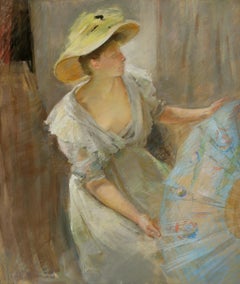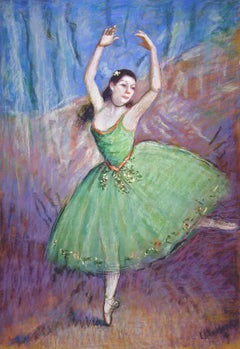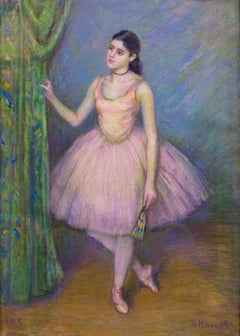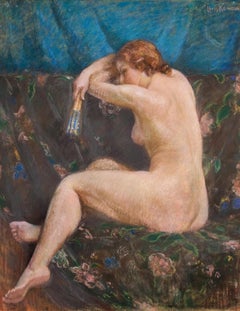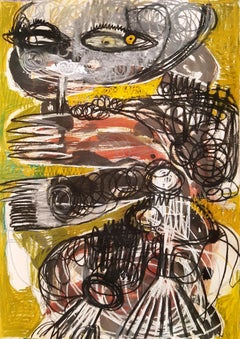Guarisco Gallery Figurative Drawings and Watercolors
to
6
6
6
1
2
3
Overall Height
to
Overall Width
to
2
6
5
3
3
3
3
2
1
1
1
1
4
1
1
2
1
4
1
1
6
6
4
4
1
Lady with Hat and Fan
By William Lee
Located in Washington, DC
Signed lower left
Category
Mid-19th Century Impressionist Figurative Drawings and Watercolors
Materials
Paper, Pastel
Céline et Pipo dans le pré
By Hughes Claude Pissarro
Located in Washington, DC
Accompanied by certificate no. 2772163 from the artist's archives.
Category
2010s Impressionist Figurative Drawings and Watercolors
Materials
Pastel, Cardboard
Dancer in Green
By Louis Kronberg
Located in Washington, DC
American Impressionist
Category
1950s American Realist Figurative Drawings and Watercolors
Materials
Pastel, Cardboard
Dancer in White
By Louis Kronberg
Located in Washington, DC
American Impressionist
Category
1940s American Realist Figurative Drawings and Watercolors
Materials
Pastel, Cardboard
Dancer in Pink
By Louis Kronberg
Located in Washington, DC
American Impressionist
Category
1940s American Realist Figurative Drawings and Watercolors
Materials
Pastel, Cardboard
Nude with Fan
By Louis Kronberg
Located in Washington, DC
American Impressionist
Category
1930s American Realist Figurative Drawings and Watercolors
Materials
Canvas, Pastel
Related Items
Cocoon - Parmis Sayous, 21st Century drawing, Iranian contemporary painter
By Parmis Sayous
Located in Paris, FR
Pastel and oil paint on cardboard
Created in 2018 in Paris, France
Unique work
Signed and dated by the artist on the back
Parmis Sayous was born in 1982 in Teheran, Iran.
Since 2015...
Category
2010s Expressionist Figurative Drawings and Watercolors
Materials
Pastel, Cardboard, Oil
Red and grey feathers- Parmis Sayous 21st Century drawing, Iranian artist
By Parmis Sayous
Located in Paris, FR
Pastel and acrylic ink on cardboard
Created in 2019 in Paris, France
Unique work
Signed and dated by the artist on the back
Parmis Sayous was born in 1982 in Teheran, Iran.
Since 20...
Category
2010s Expressionist Figurative Drawings and Watercolors
Materials
Pastel, Cardboard, Ink
A girl II - XXI century, Contemporary Realistic Figurative Mixed Media Drawing
By Andrzej Szypluk
Located in Warsaw, PL
Contemporary realistic figurative mixed media drawing
PROVENANCE
Exhibited at Katarzyna Napiorkowska Gallery.
The Gallery is a primary representative for this artist.
The Gallery o...
Category
Early 2000s Realist Figurative Drawings and Watercolors
Materials
Chalk, Pastel, Cardboard, Pencil
Symbolist Portrait of a Woman in an Interior, 'Before the Mirror'
Located in Cotignac, FR
Art Nouveau coloured drawing of a young lady beauty before a mirror by Edmon Aman-Jean. The work is signed in pencil bottom left and presented in a plain wood frame with mount, under...
Category
Late 19th Century Symbolist Figurative Drawings and Watercolors
Materials
Pencil, Crayon, Color Pencil
H 12.21 in W 10.24 in D 0.79 in
Freya (Seated Backwards), Mixed media on grey board
By Howard Tangye
Located in London, GB
Howard Tangye (b.1948, Australia) has been an influential force in fashion for decades. Lecturing at London’s Central Saint Martins for 35 years, including 16 years as head of BA Wom...
Category
2010s Contemporary Figurative Paintings
Materials
Other Medium, Archival Paper, Handmade Paper, Pen, Felt Pen, Permanent M...
small woman on a big chair, figurative, colorful, botero-like, pastel, paper
By Stephen Basso
Located in Brooklyn, NY
Stephen Basso's highly original pastels and oil paintings are romantic, yet thought provoking fantasies. His whimsical works are alive with boundless imagination, wry wit and fear...
Category
1980s Outsider Art Figurative Drawings and Watercolors
Materials
Pastel, Archival Paper
H 30.01 in W 22.01 in D 0.99 in
Nude - XXI century, Contemporary Realistic Figurative Mixed Media Drawing
By Andrzej Szypluk
Located in Warsaw, PL
Contemporary realistic figurative mixed media drawing
PROVENANCE
Exhibited at Katarzyna Napiorkowska Gallery.
The Gallery is a primary representative for this artist.
The Gallery o...
Category
Early 2000s Realist Figurative Drawings and Watercolors
Materials
Chalk, Pastel, Pencil, Cardboard
Danseuse By Pierre Carrier-Belleuse
By Pierre Carrier-Belleuse
Located in New Orleans, LA
Pierre Carrier-Belleuse
1851-1932 | French
Danseuse
Signed “Pierre Carrier-Belleuse” (lower right)
Pastel on canvas
Strikingly elegant, this extraordinary pastel by French impress...
Category
19th Century Impressionist Figurative Drawings and Watercolors
Materials
Pastel, Canvas
Le Lever - Impressionist Figures in Interior Pastel by Jean Louis Forain
By Jean Louis Forain
Located in Marlow, Buckinghamshire
Signed impressionist figurative pastel on board circa 1895 by sought after French impressionist painter Jean Louis Forain. The piece depicts a man asleep in a bed while a woman stands at the foot of the bed getting dressed. The room is dimly lit by the bedside lamp.
Signature:
Signed upper right
Dimensions:
Framed: 22"x26"
Unframed: 15"x19"
Provenance:
Galerie Jean-Claude Bellier
Jean Forain was the son of a painter and decorator and was apprenticed to a visiting card engraver. He studied briefly under Gérôme and Carpeaux at the École des Beaux-Arts in Paris and regularly visited the Louvre, where he copied works by the masters. It is said that for a time he made a precarious living by selling small drawings in the style of Grévin. He went on to collaborate on various publications as a draughtsman and columnist, starting in 1876 on La Cravache and then collaborating on the newspapers Le Journal Amusant, Le Figaro and L'Écho de Paris. This introduced him to the diverse worlds of Paris society - the world of the theatre, of shows, and of literature - where he wryly noted the habits and shortcomings particular to each. This led him to follow a route very characteristic of this period, already seen in the work of Steinlen, Caran d'Ache and Toulouse-Lautrec in the journals La Pléiade, La Vogue and La Revue Blanche.
His work draws a picture of the society of the period, not in a strictly imitative fashion but in the form of the 'dessin-charge' or mild caricature. In 1880 he illustrated Parisian Sketches...
Category
Late 19th Century Impressionist Figurative Paintings
Materials
Pastel, Board
Young Girl Reading a Book
By Adelaide Hiebel
Located in Fort Washington, PA
Signed Lower Right
Framed under glass
Category
20th Century Figurative Drawings and Watercolors
Materials
Canvas, Pastel
German Expressionist Bakers, colorful painting with food cakes
By Stephen Basso
Located in Brooklyn, NY
Pastel on toned paper
Stephen Basso's highly original pastels and oil paintings are romantic, yet thought provoking fantasies. His whimsical works are alive with boundless imagina...
Category
2010s Expressionist Interior Drawings and Watercolors
Materials
Paper, Pastel
H 27 in W 39 in D 1 in
Eileen Lake
By Adolf Arthur Dehn
Located in Fairlawn, OH
Eileen Lake
Crayon on paper, early1930's
Initialed in pencil lower right (see photo)
Titled and annotated verso "Eileen Lake, early 1930s girlfriend"
Note: Eileen Hall Lake was an American poet and Adolf Dehn's girlfriend in the early 1930s.
Provenance:
Estate of the artist
By descent
Adolf Dehn, American Watercolorist and Printmaker, 1895-1968
Adolf Dehn was an artist who achieved extraordinary artistic heights, but in a very particular artistic sphere—not so much in oil painting as in watercolor and lithography. Long recognized as a master by serious print collectors, he is gradually gaining recognition as a notable and influential figure in the overall history of American art.
In the 19th century, with the invention of the rotary press, which made possible enormous print runs, and the development of the popular, mass-market magazines, newspaper and magazine illustration developed into an artistic realm of its own, often surprisingly divorced from the world of museums and art exhibitions, and today remains surprisingly overlooked by most art historians. Dehn in many regards was an outgrowth of this world, although in an unusual way, since as a young man he produced most of his illustrative work not for popular magazines, such as The Saturday Evening Post, but rather for radical journals, such as The Masses or The Liberator, or artistic “little magazines” such as The Dial. This background established the foundation of his outlook, and led later to his unique and distinctive contribution to American graphic art.
If there’s a distinctive quality to his work, it was his skill in introducing unusual tonal and textural effects into his work, particularly in printmaking but also in watercolor. Jackson Pollock seems to have been one of many notable artists who were influenced by his techniques.
Early Years, 1895-1922
For an artist largely remembered for scenes of Vienna and Paris, Adolf Dehn’s background was a surprising one. Born in Waterville, Minnesota, on November 22, 1895, Dehn was the descendent of farmers who had emigrated from Germany and homesteaded in the region, initially in a one-room log cabin with a dirt floor. Adolf’s father, Arthur Clark Dehn, was a hunter and trapper who took pride that he had no boss but himself, and who had little use for art. Indeed, during Adolf’s boyhood the walls of his bedroom and the space under his bed were filled with the pelts of mink, muskrats and skunks that his father had killed, skinned and stretched on drying boards. It was Adolf’s mother, Emilie Haas Dehn, a faithful member of the German Lutheran Evangelical Church, who encouraged his interest in art, which became apparent early in childhood. Both parents were ardent socialists, and supporters of Eugene Debs. In many ways Dehn’s later artistic achievement was clearly a reaction against the grinding rural poverty of his childhood.
After graduating from high school in 1914 at the age of 19—an age not unusual in farming communities at the time, where school attendance was often irregular—Dehn attended the Minneapolis School of Art from 1914 to 1917, whose character followed strongly reflected that of its director, Munich-trained Robert Kohler, an artistic conservative but a social radical. There Dehn joined a group of students who went on to nationally significant careers, including Wanda Gag (later author of best-selling children’s books); John Flanagan (a sculptor notable for his use of direct carving) Harry Gottlieb (a notable social realist and member of the Woodstock Art Colony), Elizabeth Olds (a printmaker and administrator for the WPA), Arnold Blanch (landscape, still-life and figure painter, and member of the Woodstock group), Lucille Lunquist, later Lucille Blanch (also a gifted painter and founder of the Woodstock art colony), and Johan Egilrud (who stayed in Minneapolis and became a journalist and poet).
Adolf became particularly close to Wanda Gag (1893-1946), with whom he established an intense but platonic relationship. Two years older than he, Gag was the daughter of a Bohemian artist and decorator, Anton Gag, who had died in 1908. After her husband died, Wanda’s mother, Lizzi Gag, became a helpless invalid, so Wanda was entrusted with the task of raising and financially supporting her six younger siblings. This endowed her with toughness and an independent streak, but nonetheless, when she met Dehn, Wanda was Victorian and conventional in her artistic taste and social values. Dehn was more socially radical, and introduced her to radical ideas about politics and free love, as well as to socialist publications such as The Masses and The Appeal to Reason.
Never very interested in oil painting, in Minneapolis Dehn focused on caricature and illustration--often of a humorous or politically radical character. In 1917 both Dehn and Wanda won scholarships to attend the Art Students League, and consequently, in the fall of that year both moved to New York. Dehn’s art education, however, ended in the summer of 1918, shortly after the United States entered World War I, when he was drafted to serve in the U. S. Army. Unwilling to fight, he applied for status as a conscientious objector, but was first imprisoned, then segregated in semi-imprisonment with other Pacifists, until the war ended. The abuse he suffered at this time may well explain his later withdrawal from taking political stands or making art of an overtly political nature. After his release from the army, Dehn returned to New York where he fell under the spell of the radical cartoonist Boardman Robinson and produced his first lithographs. He also finally consummated his sexual relationship with Wanda Gag.
The Years in Europe: 1922-1929
In September of 1921, however, he abruptly departed for Europe, arriving in Paris and then moving on to Vienna. There in the winter of 1922 he fell in love with a Russian dancer, Mura Zipperovitch, ending his seven-year relationship with Wanda Gag. He and Mura were married in 1926. It was also in Vienna that he produced his first notable artistic work.
Influenced by European artists such as Jules Pascin and Georg Grosz, Dehn began producing drawings of people in cafes, streets, and parks, which while mostly executed in his studio, were based on spontaneous life studies and have an expressive, sometimes almost childishly wandering quality of line. The mixture of sophistication and naiveté in these drawings was new to American audiences, as was the raciness of their subject matter, which often featured pleasure-seekers, prostitutes or scenes of sexual dalliance, presented with a strong element of caricature. Some of these drawings contain an element of social criticism, reminiscent of that found in the work of George Grosz, although Dehn’s work tended to focus on humorous commentary rather than savagely attacking his subjects or making a partisan political statement. Many Americans, including some who had originally been supporters of Dehn such as Boardman Robinson, were shocked by these European drawings, although George Grocz (who became a friend of the artist in this period) admired them, and recognized that Dehn could also bring a new vision to America subject matter. As he told Dehn: “You will do things in America which haven’t been done, which need to be done, which only you can do—as far at least as I know America.”
A key factor in Dehn’s artistic evolution at this time was his association with Scofield Thayer...
Category
1930s American Realist Figurative Drawings and Watercolors
Materials
Oil Crayon
